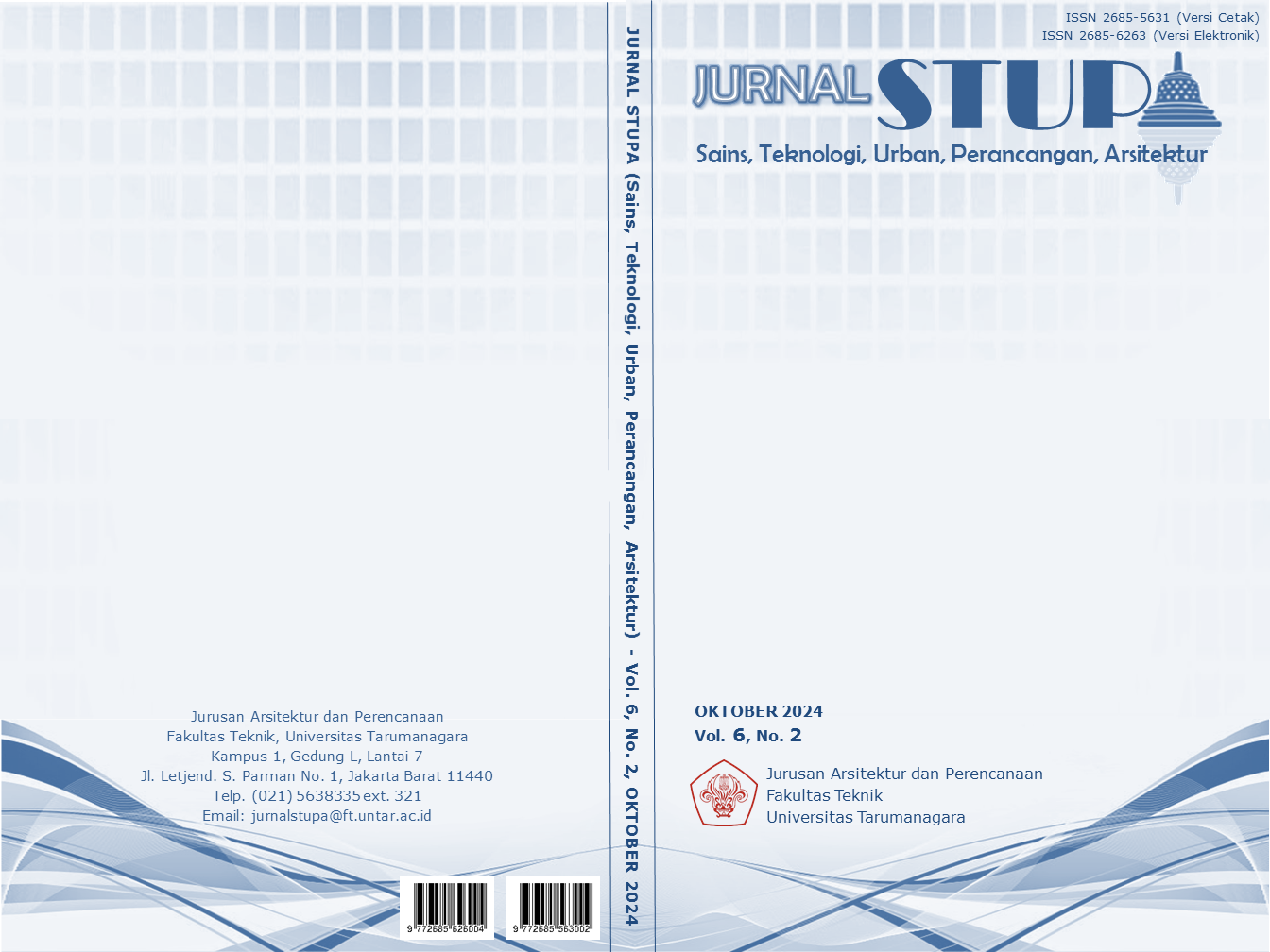PENERAPAN STRATEGI URBANISME LANSKAP DALAM PLACEMAKING DI WADUK SETIABUDI
Main Article Content
Abstract
The reservoir in Setiabudi, Jakarta, has the potential to become a meaningful place for the surrounding community. By implementing Landscape Urbanism approaches, we can create spaces that integrate green and blue elements, enhancing residents' care and ownership of the reservoir. The main goal of this project is to transform the reservoir into an attractive and beneficial "place" for local residents. Here are some strategies that can be implemented: Green and Blue Open Spaces: Introducing green and blue open spaces can address the lack of green areas and provide attractions for residents. Green areas can be used for various activities such as sports, picnics, or relaxation. Meanwhile, the blue areas (water) can be utilized for education about water quality and how the reservoir works. Active and Passive Education: Education can encompass two aspects. Firstly, active education involves experiments with water conditions, planting water-cleansing plants, and understanding the benefits of the reservoir. Secondly, passive education includes information about how the reservoir works and observing related city utilities. Involving residents in the planning and management of the reservoir will enhance their ownership and care. Through community meetings, workshops, and other participatory activities, we can ensure that the reservoir truly becomes a beloved and community-owned place. With this approach, the Setiabudi reservoir can transform into more than just infrastructure but also an essential part of residents' daily lives.
Keywords: Green and Blue Open Spaces; Landscape Urbanism; Setiabudi Reservoir
Abstrak
Waduk di Setiabudi, Jakarta, memiliki potensi untuk menjadi tempat yang berarti bagi komunitas sekitar. Mengimplementasikan pendekatan Landscape Urbanism, dapat menciptakan ruang yang menggabungkan elemen hijau dan biru, serta meningkatkan kepedulian dan rasa kepemilikan warga terhadap waduk tersebut. Tujuan utama dari proyek ini adalah mengubah waduk menjadi sebuah “place” yang menarik dan bermanfaat bagi warga sekitar. Berikut adalah beberapa strategi yang dapat diterapkan: Ruang Terbuka Hijau dan Biru: Ketika memperkenalkan ruang terbuka hijau dan biru, dapat mengatasi kekurangan area hijau dan memberikan atraksi bagi warga. Area hijau dapat digunakan untuk berbagai aktivitas, seperti berolahraga, berpiknik, atau sekadar bersantai. Sementara itu, area biru (air) dapat dimanfaatkan untuk edukasi tentang kualitas air dan cara kerja waduk, edukasi aktif dan Pasif dapat mencakup dua aspek. Pertama, edukasi aktif melibatkan eksperimen dengan kondisi air, penanaman tanaman yang memperbaiki kualitas air, dan pemahaman tentang manfaat waduk. kedua, edukasi pasif melibatkan informasi tentang cara kerja waduk dan observasi terhadap utilitas kota yang terkait, melibatkan warga dalam perencanaan dan pengelolaan waduk akan meningkatkan rasa kepemilikan dan kepedulian mereka. Ketika mengadakan pertemuan komunitas, workshop, dan kegiatan partisipatif lainnya, dapat memastikan bahwa waduk benar-benar menjadi milik dan tempat yang dicintai oleh warga sekitar. Dengan pendekatan ini, waduk di Setiabudi dapat bertransformasi menjadi tempat yang lebih dari sekadar infrastruktur, tetapi juga sebagai bagian penting dari kehidupan sehari-hari warga.
Article Details

This work is licensed under a Creative Commons Attribution-NonCommercial-ShareAlike 4.0 International License.
This work is licensed under a Jurnal Sains, Teknologi, Urban, Perancangan, Arsitektur/ STUPA Creative Commons Attribution-NonCommercial-ShareAlike 4.0 International LicenseReferences
Anadol, R. (2020). Urban Futures (Vol. 90). Los Angeles: HIVOS. Diambil kembali dari https://onlinelibrary.wiley.com/toc/15542769/2020/90/3
Antonio José Garaycochea, J. M. (2023). Landscape Urbanism. Diambil kembali dari aaschool: https://www.aaschool.ac.uk/academicprogrammes/postgraduate/landscape-urbanism
Authority, U. R., Eveland , J., & Zhuang, J. (2020). Skyline : Insight into planning spaces around us (Vol. 13). Singapore: Urban Redevelopment Authority. Dipetik Oktober 3, 2023, dari https://www.ura.gov.sg/-/media/Corporate/Resources/Publications/Skyline/Skyline-PDFs/Skyline_Issue_13.pdf
Cao, L. (2020, January 1). Innovative Uses of Water in Architecture. Diambil kembali dari Archdaily: https://www.archdaily.com/931070/innovative-uses-of-water-in-architecture
Freestone, R. (t.thn.). Place and Placelessness revisited.
JAYA, P. P. (2021). PD PAL JAYA. PEMERINTAH PROVINSI DAERAH KHUSUS IBUKOTA JAKARTA, 12 - 16.
Miranda, L. (2014). Friends of Reservoir. Dalam L. Miranda, Reservoir Fish Habitat Management. Friends of Reservoirs. (hal. 42 - 60). Colombo, Sri Lanka.
Najle, M. M. (2003). Landscape Urbanism. Dalam M. Mostafavi, Landscape Urbanism: A Manual for the Machinic Landscape (hal. 212-213). Cairo, Egypt.
Project for Public Spaces. (2021). What Makes a Successful Place? Diambil kembali dari Project for Public Spaces.
Souza, E. (2020, June 4). Tips for Using Rainwater in Architectural Projects. Diambil kembali dari Archdaily: https://www.archdaily.com/940535/tips-for-using-rainwater-in-architectural-projects
Waldheim, C. (2016). Constructing Landscape . Dalam C. Waldheim, Landscape as Urbanism: A General Theory (hal. 42 - 60).



